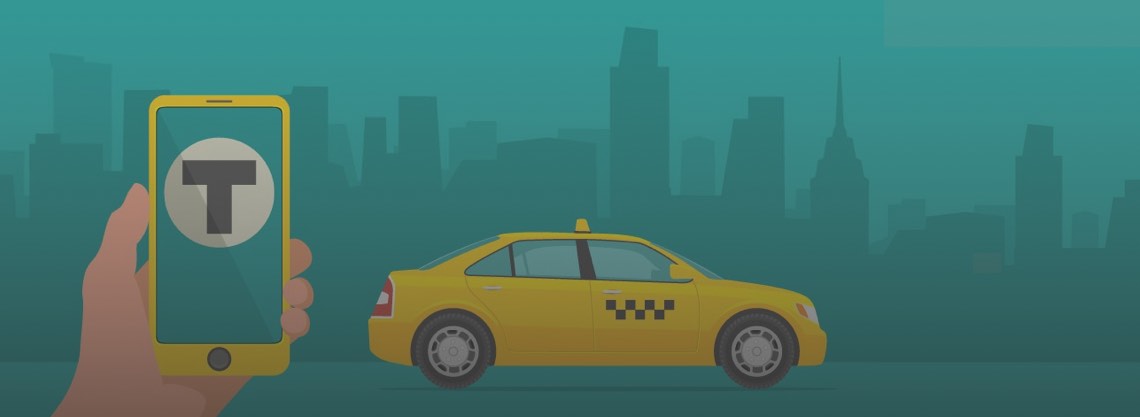Uber, Instacart, Netflix, and Grubhub – on-demand service apps have smoothly and sweepingly entered our daily lives. At one point, the fresh wave of on-demand service mobile applications for iOS and Android marked a sharp reversal in how businesses provide their services to customers. Not only is it that everyone is so busy with their careers and families that there is no time left on routine tasks like shopping, cooking, driving, or housekeeping. There have been a number of global societal changes in the recent past that resulted in the growing popularity of on-demand services.
These useful mobile apps aim to target customers who need fast and easy access to services. In response, the market meets this demand creating the perfect buying environment where people can be sure about the quality, convenience, and trustworthiness of the service delivery process.
We’ve collected and analyzed the recent statistical data and are ready to present an in-depth on-demand market landscape overview followed by some basic rules of successful on-demand service app development. In this article, we will also look into what an on-demand service platform is and how this business model works, what types of on-demand service apps are there, and what steps you should take to make your own on-demand service application.
What is an on-demand service app?
On-demand service apps are service platforms that connect waiting-time-sensitive customers with independent service providers or agents. Such an app serves as a mediator between a business and a customer, allowing them to find each other in the first place and engage in a customer-provider relationship on mutually satisfactory terms. These transactions are different from those in a traditional employer-employee relationship. The mediation of these relationships doesn’t fit any conventional model of cooperation either. Instead, it is a large-scale rethinking of labor laws that is still ongoing.
These applications have gained their popularity due to their ability to meet the demand of each particular individual. Besides, as the number of mobile users keeps growing, user expectations shaped by this shift have also risen so much that users expect to get what they need at nearly any given moment by tapping a couple of times on the screen. The bar has been raised so high that there is no other option than comply with the standards.
To give you a clearer picture of the on-demand service market landscape, we suggest you take a look at some recent statistics, trends, and data.
According to the National Technology Readiness Survey (NTRS,) from 2018 to 2019, the US on-demand economy reportedly grew by 18%. Also, the report offered the analysis of participation in the on-demand economy by category in 2016-2019:
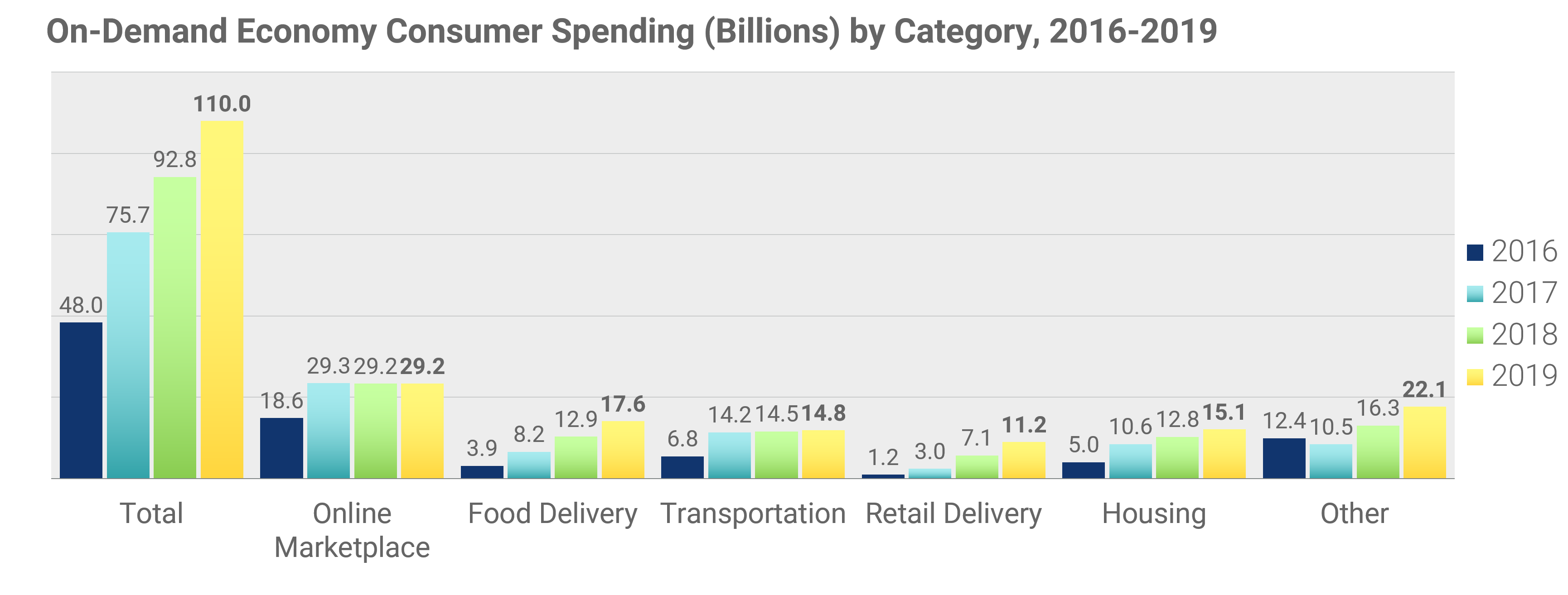
Another analysis by NTRS found that the number of on-demand consumers doubled from 2016 to 2018 (25 and 56 million, respectively.)
According to the research by eMarketer, the number of smartphone food delivery app users in the US will reach 53.9 million by 2023 compared to 36.4 million users in 2019:
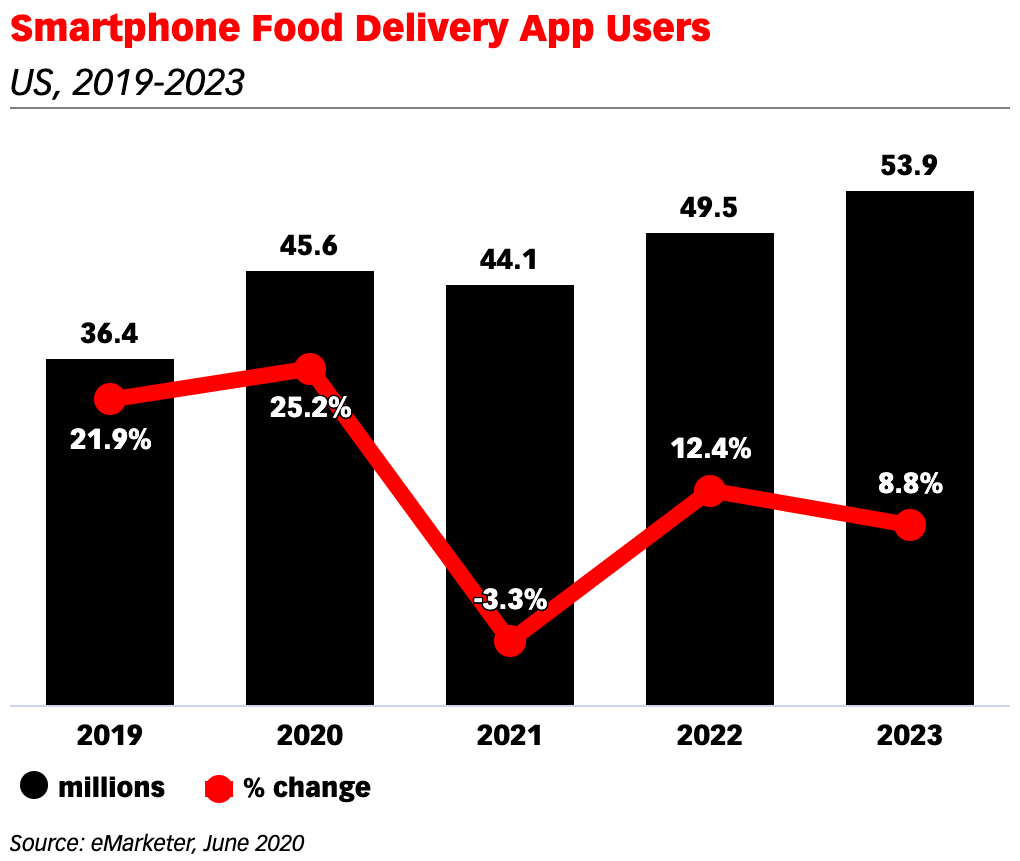
Of course, we could go on with more industry-specific statistics. However, there is actually no need to do so. The upward trend is easily observed across all the on-demand service categories. Especially in the light of the COVID-19 pandemic, people tend to use on-demand services even more frequently and willingly. So, let’s not labor the point and find out how an on-demand service business model works.
How an on-demand business model works
Generally speaking, with on-demand self-service, customers are free to decide which services to use or subscribe to and how much to invest in using them. Everything is available at the swipe of a credit card or through an online payment system.
Companies like Uber or Netflix connect people who want goods (e.g., a meal from a restaurant) or services (e.g., video streaming) with people who can provide them with what they are looking for for a certain price.
Usually, on-demand service apps focus on a single domain area like Airbnb that helps people find housing, Lyft that provides transportation, and GrubHub that allows ordering meals. Sometimes such specialization results in one company launching and running multiple businesses across different domains, as it happened with Uber and Uber Eats becoming two separate applications. This way, it remains relatively easy for consumers to navigate through a segmented service marketplace. They always know which app to open when searching for a particular thing they want, be it food, taxi, housing, or entertainment.
An on-demand service business model is also characterized by immense delay sensitivity and high agent independence. In other words, users expect goods and services to be delivered immediately. On the other hand, agents (service providers) serve as independent contractors in the sense that they decide whether and when to work and receive payments from the platform for each service completion.
An on-demand model enables access to a larger pool of service providers and customers and is meant to drive a better customer experience. Therefore, on-demand service platforms are usually developed in the form of both a mobile app and a web app for users to get to what they want faster and more easily. These apps are, in turn, managed through the admin dashboard that allows you to watch over every single ongoing and completed operation.
Types of on-demand service apps
The key part of the on-demand industry is knowing what people want and which way of getting it is the most natural for them and seamless for the agent. Basically, there are three options. Customers and clients of a business can access services following business-to-customer (e.g., Netflix,) business-to-business (e.g., Glovo’s upcoming B2B logistics unit,) or customer-to-customer (e.g., Airbnb) model.
Categories of services and products delivered within the on-demand business model framework also differ considerably. No matter whether it is B2B, B2C, or C2C – the receiving party will appreciate it if the platform is not only capable of connecting them with the provider but also can save their time and make their life a bit better along the way. As of today, there are several categories in which such improvements have become and repeatedly proved feasible.
In a way, all these categories can be clustered together to form a group of online marketplace apps.
As a type of eCommerce app, an online marketplace is an on-demand platform where product or service is provided by numerous third parties. On-demand marketplaces are per se an umbrella term that covers a whole bunch of subcategories, including but not limited to:
- Consumer goods: Etsy, eBay, and Poshmark
- Crowdfunding: Kickstarter, Patreon, and Gofundme
- Education: Udemy
- Recruiting: Indeed, Glassdoor
- Delivery: Instacart, Postmates
- Food: Seamless, Doordash, and OpenTable
- Transportation: Uber, BlaBlaCar, and Lyft
Let’s discuss some of these categories in a bit more detail.
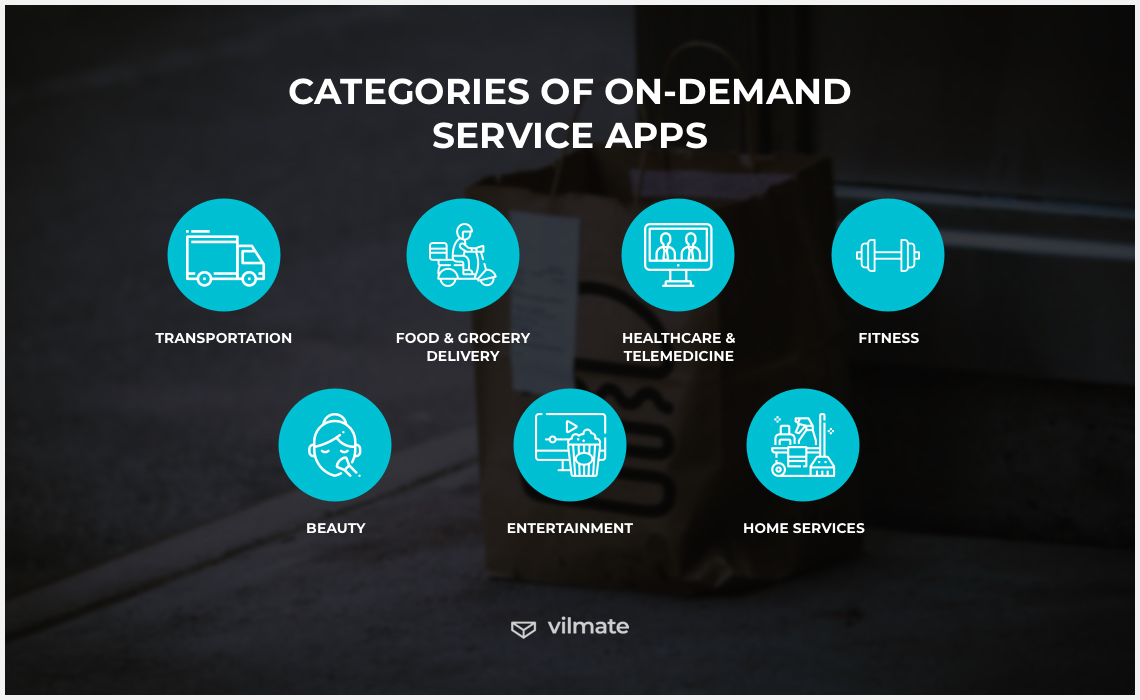
1. Transportation: logistics & taxi-hailing
On-demand transit isn’t new. Dial-a-ride has been around for quite a while and is still in use. However, technology has evolved to make on-demand transportation services even more accessible to a wider audience.
That said, it should be noted that the global on-demand transportation services market is segmented. There is differentiation by type, vehicle type, and business model. Therefore, we can single out apps for passenger transportation and goods transportation.
Of course, the discussion of the on-demand economy would be incomplete without mentioning passenger ride-hailing services like Uber and Lyft. Such on-demand businesses can adequately compete with traditional taxi companies, making the latter rethink how they deliver their services and how to improve the customer experience. With taxi e-hailing platforms, people are free to order a ride at any time and nearly anywhere. Also, what makes on-demand ride-hailing companies stand out is their relatively bigger fleet size, broader reach, high level of flexibility, agility, and investment capabilities.
It is not as cut and dried in the case with logistics on-demand applications as it is with passenger transportation apps. On-demand logistics is a highly controversial sector. Tellingly, the two industry-leading providers UberRUSH and Shyp both eventually decided to close up shop instead of fighting to stay afloat. The on-demand logistics niche has plenty of pitfalls. Transportation services are complex, and there are many things to consider when working out the logistics: fleet maintenance, labor pool training and development, goods handling, order tracking, and more.
So no wonder that startups feel somewhat uncertain about trying to succeed by operating in this market segment. On the reverse side, those who do choose to try will face little to no competition.
2. Food & grocery delivery
The on-demand delivery model is here to stay, and the ongoing success of on-demand food & grocery delivery apps proves the point. In April 2020, the global Google searches for “food delivery” sky-rocketed, reaching new heights. The pandemic crisis has impacted the way people get groceries and food.
The food & grocery delivery sector is definitely one of the most popular on-demand service categories. And its popularity has never been as predictable and consistent as it is now. For instance, according to Statista, as of March 2020, the U.S. market experienced substantial growth in grocery delivery app downloads due to the coronavirus pandemic. On top of it, according to Brick Meets Click/Mercatus Grocery Survey, U.S. online grocery sales reached $7.2 billion in June, which is a 9% increase over May. 45.6 million households used delivery and pickup services in June 2020 compared to 16.1 million in August 2019.
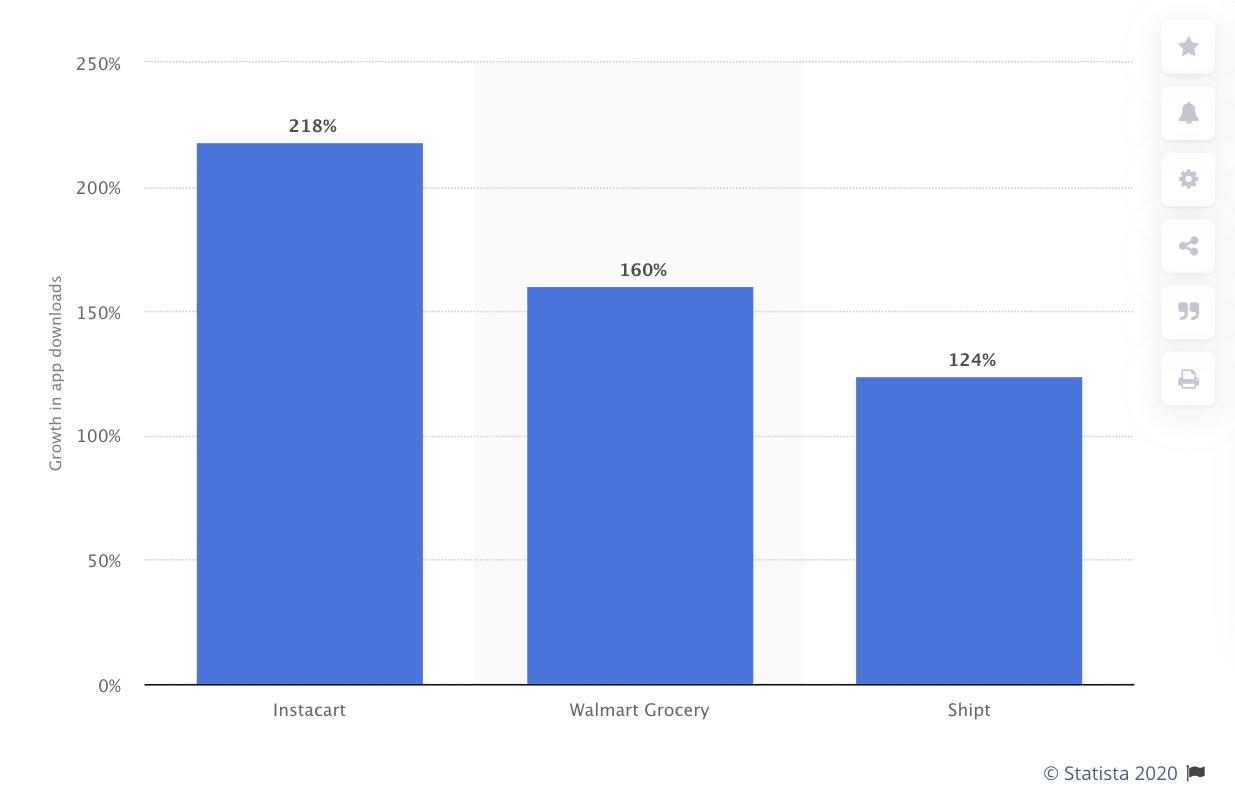
That said, the increased popularity also means a higher competition rate. Nevertheless, it is not a bad thing at the end of the day. Online grocery shopping and food delivery app providers’ progress should not discourage you. Instead, it should inspire you to take advantage of what others have already tested and proved effective and launch your own product, adding a twist to its feature set. Thus, one of the food & grocery delivery best practices is to create different products for customers, delivery people, store managers, and admins.
Apps like UberEats, GrubHub, Instacart, Glovo, and Postmates demonstrate that customers need an on-demand delivery service to get groceries from their favorite grocery stores and food from their favorite restaurants without leaving home. It means on-demand food & groceries delivery is very likely to remain popular among customers, so we must say more advancements in this sector are yet to come.
3. Healthcare & telemedicine
Whether you can’t find time to see a doctor, you are in a far-off location, or you don’t want to expose yourself to the coronavirus, on-demand healthcare service apps are there to help you.
The telemedicine industry is quickly developing now, continuously adopting the most up-to-date technologies to ensure the end products’ high quality. Telemedicine apps are also known as doctor on-demand applications, which means their main goal is to safely, securely, and seamlessly connect people seeking medical consultation with medical professionals capable of providing it.
Using on-demand apps like Zocdoc, Healthtap, Doctor on Demand, and LiveHealth Online, one can find needed specialists, check their ratings and certifications, schedule appointments, and receive consultations online via a video call. Calling a doctor on-demand is not the only feature of telehealth apps. Such apps can also come in handy for remote patient monitoring, collecting health data, requesting a doctor visit, wireless testing, prescription monitoring, and more. The full potential is still to be discovered.
What can be stated with complete certainty is that for on-demand healthcare apps to become legitimate, they must comply with all applicable laws and regulations, such as HIPAA, GDPR, and MDR. A complex regulatory environment is not the only challenge, though. The growing competition and difficulties associated with health insurance management can stand in the way of your aspiration to make healthcare accessible on-demand to anyone who owns a smartphone or a PC.
4. Fitness
Regular workouts are an integral part of a healthy lifestyle. In 2020, fitness apps can go above and beyond, providing you with highly personalized on-demand fitness services. The statistics on trends in the fitness industry manifest the truth of the statement:
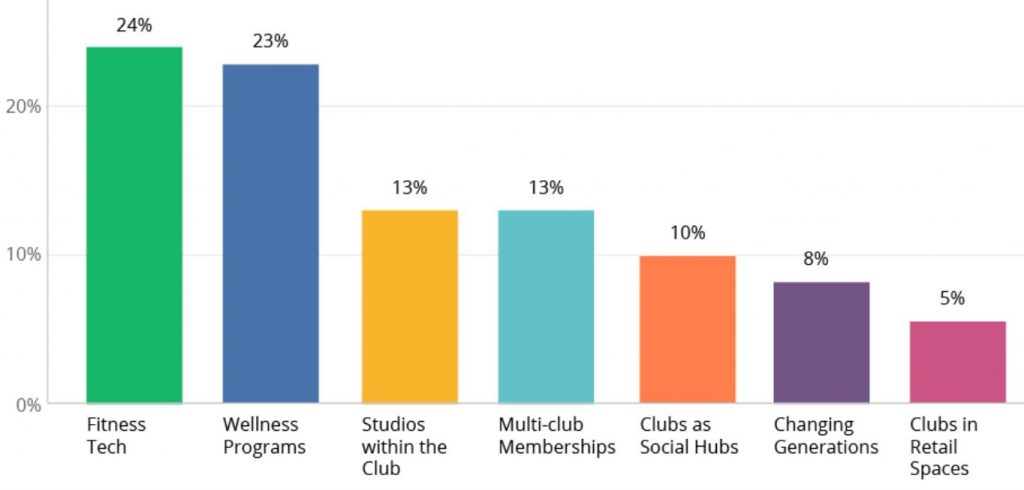
First of all, a personal trainer right on your smartphone or a comprehensive collection of home/gym workout programs at the reach of your fingertips is convenient. Then, it will be more problematic to keep finding reasons to postpone your hitting the gym.
The on-demand model is genuinely transforming the way the fitness industry works. With an on-demand fitness app, customers can request both online and onsite training guided by a fitness expert of their choice. Just imagine your personal trainer comes to your living room and you say that you don’t feel like squatting, or you schedule an online workout but do not show up. That’s rude. It is a real commitment, and you should probably be ready right away for your exercises.
Online fitness marketplaces are all set to benefit both trainers and users requesting a workout. You will also get access to all other perks inherent in the on-demand business model like flexibility, reliability, easy booking and payment, ratings, and reviews.
5. Beauty
Mobile beauty apps are also beginning to offer on-demand services to clients. Of course, it was possible to invite a beauty master to your home before the pandemic. However, now this all is getting to a whole new level.
Beauty-on-demand has all chances to turn out a successful investment. The year 2020 has started the disruption of brick & mortar spa and beauty salons. Beautystack, BeYou, and Soothe are only a couple of on-demand beauty service applications for booking stylists and therapists. People still want to spend money on quality personal care. It is just the format of the booking and providing of this care that has changed.
Using at-home salon beauty services, hiring a beauty professional to complete a makeover for a special occasion, getting beauty products delivered to one’s home, booking an appointment at a beauty salon or spa center, or getting any other skincare and wellness services at the comfort of one’s home – beauty-on-demand apps offer these services already today!
So, why not take advantage of what the industry has to offer, save time, and minimize the chance of exposure to the coronavirus by enjoying one’s favorite beauty and wellness services at home? After downloading the app, the user normally can easily book a local beauty professional choosing from among the options listed on the app. When the booking is confirmed, a stylist contacts the client, they arrange the time and place for the appointment where the selected services will be executed.
6. Entertainment
Entertainment-on-demand is booming. The introduction of on-demand streaming services like Netflix and Amazon Prime has dramatically changed how people prefer to watch TV shows, TV series, documentaries, and movies.
Today, numerous video-on-demand services compete for prospective customers’ business, while new ones debut increasingly more often. The number of on-demand consumers keeps growing accordingly. For instance, as reported by Statista, in the 3rd quarter of 2020, the number of Netflix paid subscribers worldwide reached 195.15 billion.
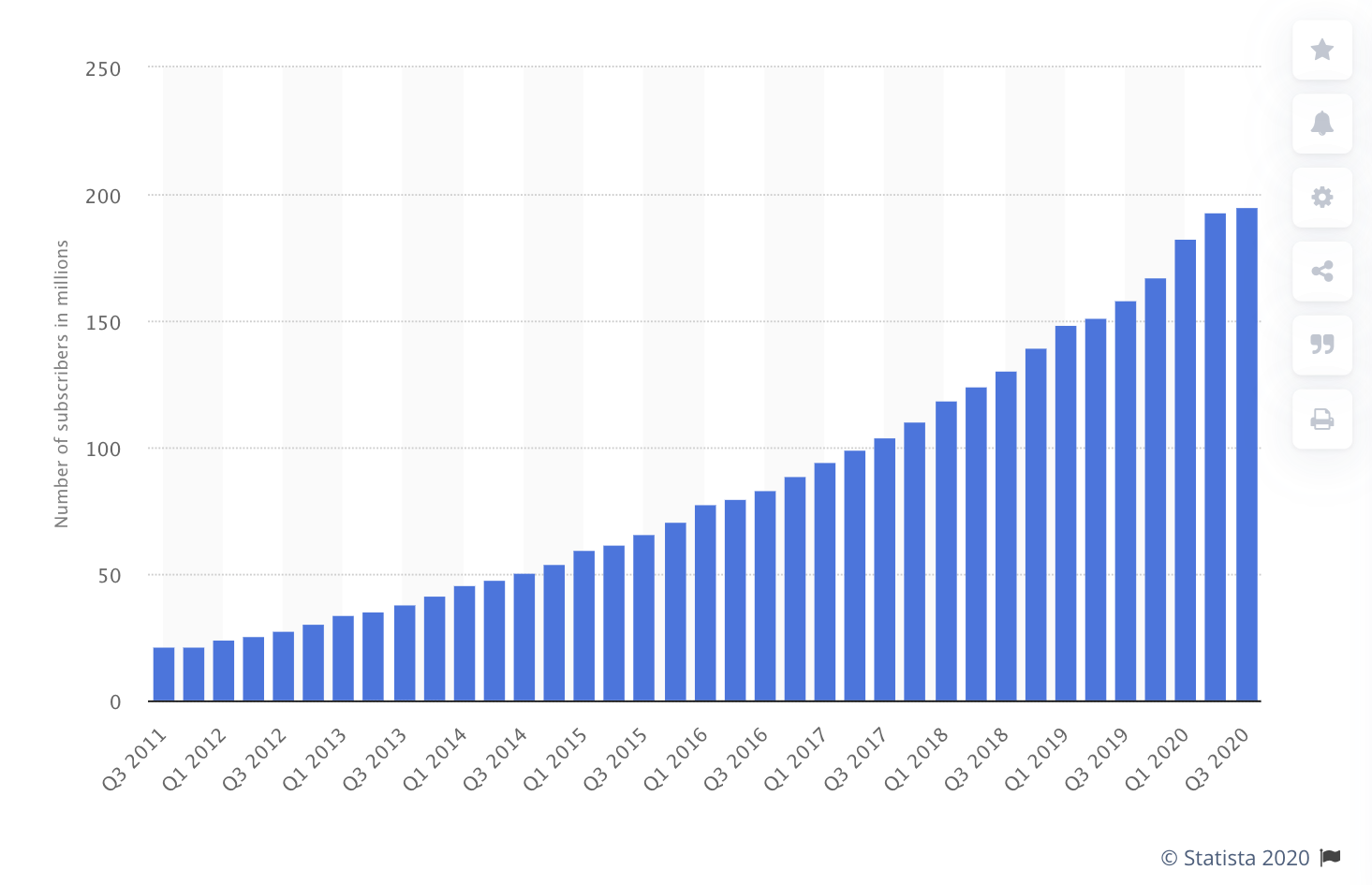
However, the competition in this sector is fierce. Not all video streaming startups succeed. Some of them unexpectedly fail. This is exactly what happened to Quibi, a startup that raised $1.75 billion but failed only 6 months after it debuted in April 2020. So, there are lots of examples to look up to and learn from. Success is fragile when it comes to video-on-demand services. One way or the other, people need entertaining content tailored to their preferences, and at the end of the day, one can never know what idea can turn out another Netflix.
7. Home services
Online on-demand home services are forecast to grow by over USD 1.5 billion from 2020 to 2024.
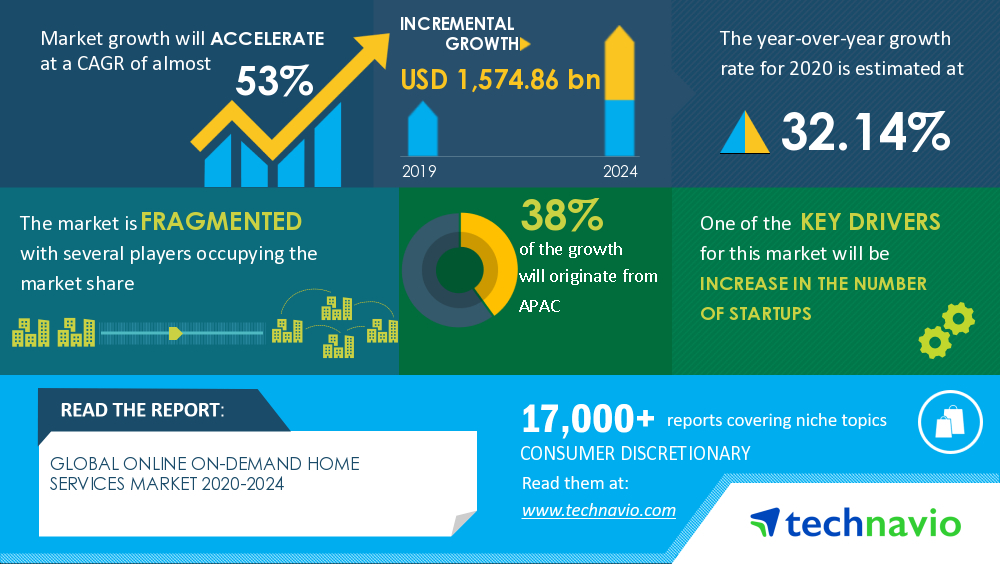
All on-demand domestic services can be classified as follows:
- House cleaning & repair services
- Packing and moving
- Babysitting
- Pet care
- Others
Online on-demand home service apps can grant users access to a large pool of registered professionals who will take care of their homes, children, and pets. Customers need a simple tool for booking cleaning and other home services online. This tool should also enable price comparison, guarantee each contractor’s credibility, and allow checking out reviews and ratings. Such a demand has given rise to many new online home services emerging in the form of both web and mobile apps. Also, users can either choose to request assistance from an independent organization that employs workers directly or opt for a marketplace that serves as a mediator connecting customers with specialty contractors.
How to build a successful on-demand service app?
On-demand service apps differ a lot. Using a ride-hailing app, we keep our expectations not too high. If the driver arrives in time, doesn’t get lost, and the car is clean, the service quality can be considered fine. However, there are more elaborate services like babysitting, medical advice, a facial, or a haircut that demand a much higher level of expertise. Then it won’t suffice if a random person shows up to do any of those things. We expect a professional in their field to take care of us.
One way or the other, there are still distinct basic principles, according to which all on-demand service apps for Android and iOS are being built. We suggest you should take these five steps to create your successful on-demand service application:
1. Choose a niche. Your unused growth capacity can go beyond the categories we mentioned above. There is more to explore in the realm of on-demand services. So, keep your options open and do not focus on the area where other companies have already found their success. Find your own specialty but remember that it’s not enough just to fill the niche. This niche must be filled with a product that people will love, the one that will make their lives better. Make sure that the end-product Reliable, user-friendly, and available at all times.
2. Start locally. Start small, think big, they say. This is precisely the case when you should follow the advice. It’s always a good idea to explore and probe first before you commit entirely to the business. It is wiser to fix the flaws and take your time to tie up loose ends when there is not too much at stake. Operating locally, you will be more likely to have things under control – be it recruiting new contractors, logistics management, professional training, marketing, or app updates.
3. Define your target audience. Knowing who is that particular person your service is set to benefit from is crucial for your enterprise success. It actually is not essential if you think your app is flawless. Your audience must be convinced of it. Always develop a product with the end-user in mind. And the number of attempts for you to demonstrate the efficiency of your on-demand service app to the prospect user is very limited. Do thorough market research, conduct beta testing, and do not forget to look through our article on what mistakes to avoid in your marketing campaign.
4. Define a pricing strategy. Finding the right pricing strategy is the top priority for any for-profit business. For some on-demand service apps, it is the provider who sets the pricing, while in a traditional on-demand marketplace, sellers define their own prices, and you can only charge a service fee. However, when it comes to money, the chance you will make a blunder is always there. The most dangerous strategy is to price too high. Don’t be greedy. It can make you incapable of meeting the competition and undermine all the efforts taken to create the app.
5. Decide on the functionality. Sure thing, the functionality of a beauty-on-demand app will differ from the one in a telemedicine application. Besides, you will probably have to create an app for customers, an app for service providers, and an admin panel, which all require different features. Nevertheless, there are some basic features that any on-demand service app won’t do without.
-
User registration and authorization. App users must be able to easily create and set up their profiles. It will provide you with essential behavioral information and allow customers to view registered agents’ detailed profiles.
-
Product or service search, filters, and lists. Filters, lists, and catalogs help users navigate the app and spend less time searching for an ideal specialist.
-
Map integration and live delivery tracking. With the help of geolocation services, customers and independent service providers will be able to check each other’s whereabouts and thus find out the estimated time of arrival.
-
Shopping cart and order summary. Be it an appointment with a doctor or stylist, today’s lunch, or a ride, customers should be able to review their order, modify it, cancel it if needed, and confirm the details.
-
Payment methods integration. Having multiple robust payment gateways is a must for any on-demand service app. Ensure it is seamless and secure for app users to pay for services and that agents face no difficulty when retrieving the money.
-
Ratings and reviews. This feature is mandatory for any app that is meant to serve as a place where service providers and service recipients meet. By checking reviews and ratings, customers can make an informed choice and eventually have a more satisfying experience.
Conclusion
Some of the most revolutionary digital products released to the market over the past years have been on-demand service apps. Luckily, there’s still a lot of room for new entrants and plenty of niches left for on-demand service apps to fill. Delivering service directly to people who need it can actually change lives for the better.
If you have an idea for an on-demand service app but are not sure where to start, Vilmate’s team of app designers and developers is there to help you turn your vision into a reality! Reach out to us today, and let’s get talking!

© 2021, Vilmate LLC



